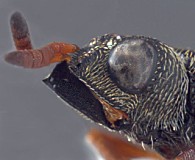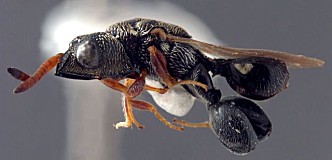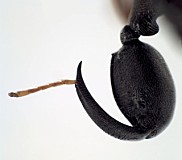Dirhinus
Remarks
Members of the genus Dirhinus have been reared numerous times from tephritid puparia, and though most of the records probably refer to a single species, at least three species have been recorded from fruit-infesting Tephritidae (Boucek and Narendran 1981). The species of this genus burrow through the substrate to locate puparia. Oviposition is through the puparial wall onto the host pupa (Silvestri 1914).
See Boucek and Narendran (1981) for important information on hosts and identification of species from earlier literature.
Also see the Dirhinus giffardii species page for much additional information.
Description
The species of Dirhinus can be readily recognized by the fact that the antennae are inserted in a deep concavity formed by two ridges extending out from the face (Figs. 1-2). In dorsal view, these appear as two horn-like protruberances.
Distribution
No referenced distribution records have been added to the database for this OTU.
Biological Control
Dirhinus giffardii (Silvestri) was brought from Africa to Hawaii by Silvestri (1914). In Hawaii, it was propagated, released, and became established on medfly, Ceratitis capitata. Later (1971), this species was introduced as a biological control agent in Bolivia against medfly (Bennett and Squire 1972).





